Mirka Knaster is a fibre artist who views every work of fibre as a journey into colour, line, texture, pattern, shape and space. Her pieces emerge intuitively or serendipitously, and she lists East Asian aesthetics, 20th-century abstract art and meditation practice as her most important influences.
Mirka has journeyed far and wide in her lifetime; born along the Adriatic Sea, she was educated on the east and west coasts of the US where she earned her BA, MA and PhD. She has lived in the Andes, Blue Ridge Mountains and Hawaiian Islands, and traversed much of Latin America, Europe, Asia, southern Africa, New Zealand and beyond.
She now works from her studio perched on the Sonoma coast of northern California, where an environment dominated by the Pacific Ocean provides constant inspiration.
Her award-winning 2-D and 3-D works have been exhibited internationally in museums, galleries, and art centres. She has taught and given presentations in the US and South Korea and served as curator or co-curator of fibre art shows in California and Nevada. She has helped to organise and facilitate textile tours to South Korea.
She is a member of Surface Design Association (SDA), a board member of the Textile Arts Council of the DeYoung Museum, San Francisco, and former member of Textile Society of America.
She discusses various aspects of the arts in the blog exploringtheheARTofit on her website: mirkaart.com.
Mirka describes the moment she realised fibre art was her heritage, how her set of hand-stitched hanji paper works ‘Journeys into the Unknown’ came about, and how travel restrictions in 2020 allowed her to deepen her journey within.
Name of piece: Journeys into Unknown Territory
Year of piece: 2019
Techniques and materials used: 36 inches H x 80 inches W, Techniques: mark-making with a variety of embroidery stitches, Materials: hanji (Korean handmade paper), embroidery floss, perle cotton, raffia, wool yarns
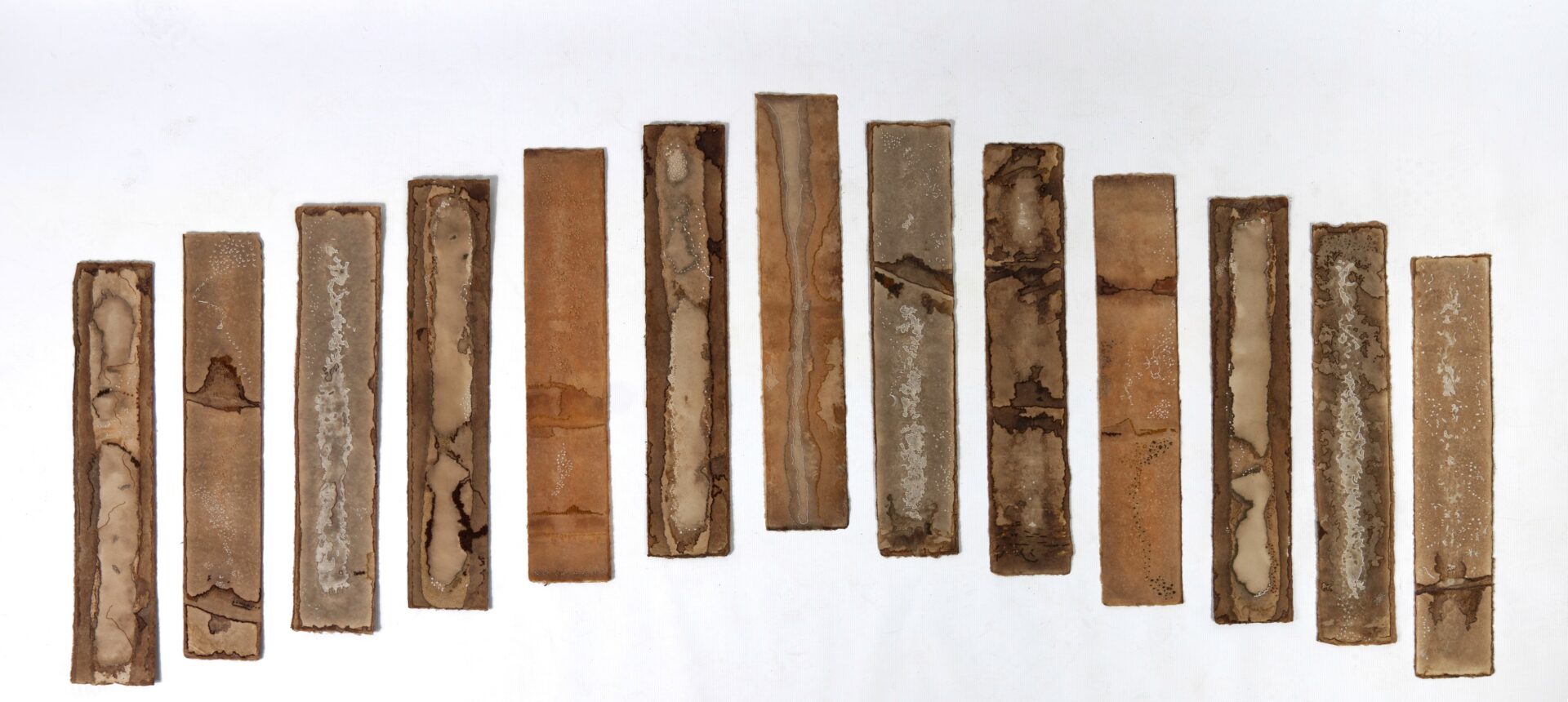
Open-ended improvisation
TextileArtist.org: How did the idea for the piece come about? What was your inspiration?
“Journeys into Unknown Territory” does not fit neatly into the category of “conception to creation.” It’s not the result of an idea I thought of and then sketched out to be materialized. Unless I am invited to submit artwork for an exhibition with a particular theme, I don’t start with a concept. Instead, with each new piece, I undertake a journey into unknown territory again and again.
When I first began to work on Journeys, I had no project in mind and certainly no title. I could not have predicted that it would wind up being a metaphor for various aspects of my personal odyssey. For instance, I came to fiber art via a highly indirect route. Unlike many fiber artists, my educational background did not focus on the fine arts, except for a few classes. I majored in Romance languages and minored in English literature, immersing myself in other cultures through these subjects as well as anthropology, before traveling around the world. My graduate studies focused first on Latin America and later on Comparative Religion. I have roamed across continents that are fascinating in their unfamiliarity. Each culture has left deep impressions. I didn’t realize that they were exerting an unconscious impact, for I didn’t foresee becoming a fiber artist.
I also couldn’t anticipate that learning how to knit, crochet, sew, embroider and mend from my mother when I was a child would prepare me for certain experiences later in life. During my hippie years, when we made almost everything ourselves—from bread to suede jackets—I embroidered my shirts and jeans, knitted and crocheted gifts, did crewelwork, and used rug hooking to create wall hangings based on Mayan designs.
It took several decades before I turned to textile art full time. What a surprise when I realized there was a long thread connecting my family’s history and my passion for fiber. It occurred after a solid career as a writer/editor in different fields. One day, it suddenly struck me that there I was, the granddaughter of a man who had worked in the once-famous textile industry of Łódź, Poland, at least a century earlier. I had unexpectedly remembered something my father told me about his father: he had a particular expertise of looking at a piece of cloth (most likely woollen) through a loupe to discern how it had been woven and, thus, how a loom should be set up to create a design. I never met him, so there was no direct influence; he died of typhus just after World War I. You can read my post about this for Textile Society of America here.
My creative process is another kind of journey into unknown territory. When I manipulate materials, I don’t know what they will become, or where they will go. I compose in open-ended improvisation. The materials, physical sensations and thoughts guide me as I engage with colour, texture, line, pattern, shape, and space. Curiosity leads to serendipity.
That’s why I can’t claim to have had a clear idea — actually any idea at all — before embarking on “Journeys into Unknown Territory.”
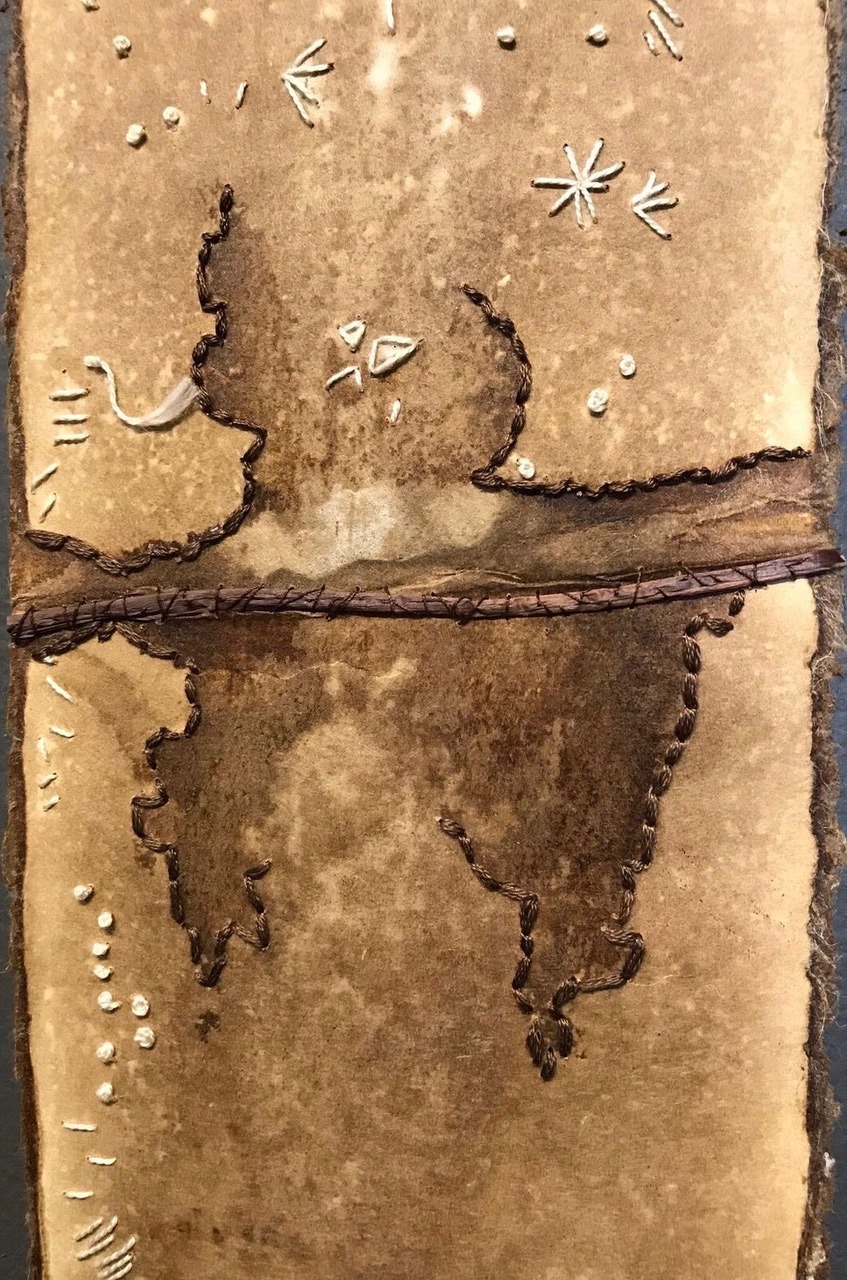
What research did you do before you started to make?
I didn’t carry out any research. The series evolved gradually and fortuitously. I was travelling to South Korea annually for a few years as part of a textile tour I helped to originate. In 2016, I wandered into Jang Ji Bang, a shop that features hanji (Korean handmade paper), located only a stone’s throw from our hotel in Insadong, a neighbourhood in Seoul. There, I came across the strips you see in the photos. Why merely strips, I don’t know. My grasp of Hangeul (Korean) was not good enough to ask and then understand a response. Maybe they were somehow left over from the distinctive large sheets that the papermaker, Master Jang, produces (You can see how he works here). Those pieces, though exquisite, were far too big to fit in my suitcase without damaging them, but the strips were easy to roll up and bring home.
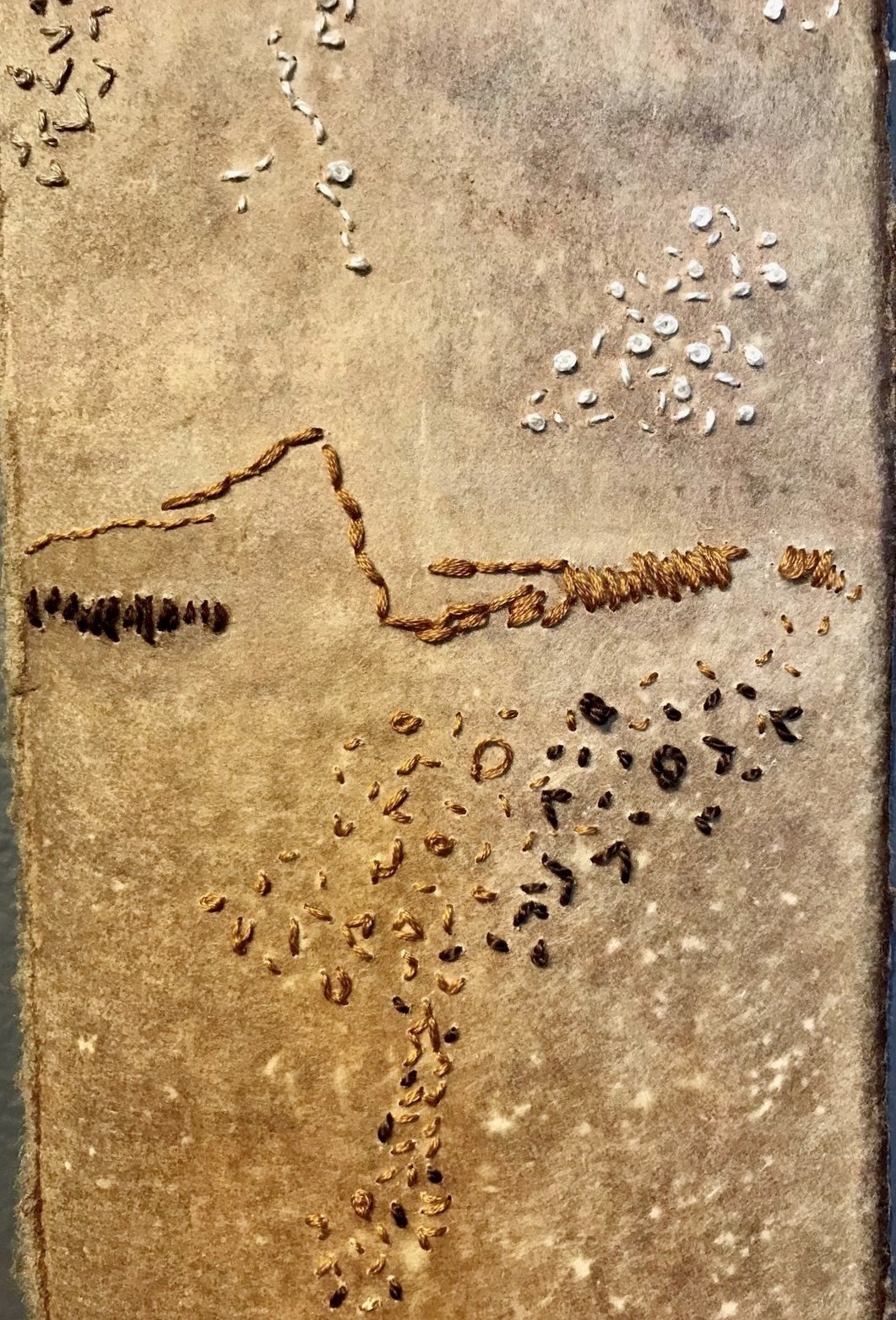
Organically hand-made
Was there any other preparatory work?
There was no preparatory work as such because there was no specific research.
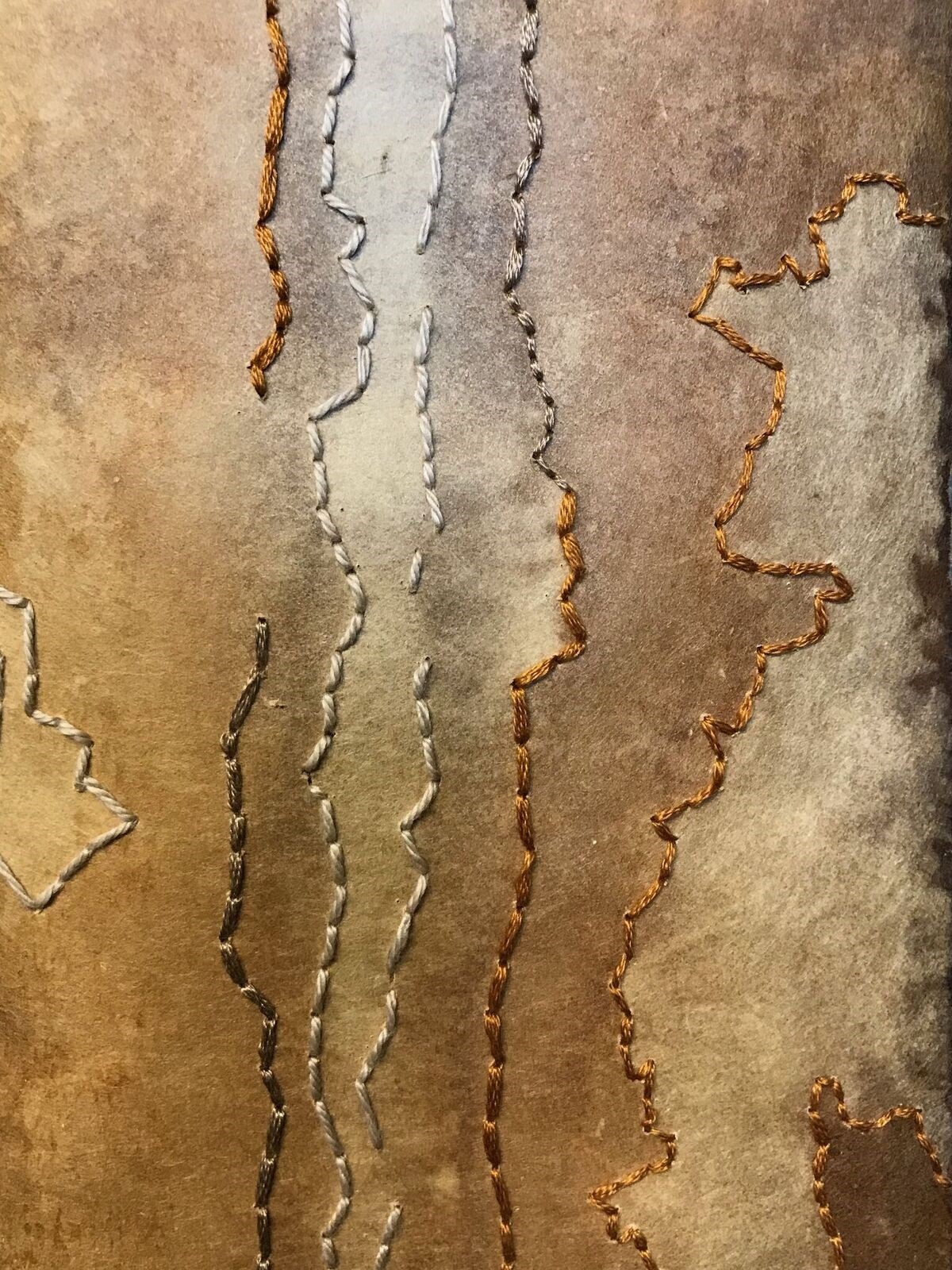
What materials were used in the creation of the piece? How did you select them? Where did you source them?
I can’t describe why I was drawn to the hanji strips; perhaps it was their totally organic nature. I sifted through several piles until I decided which most appealed to me. As someone who, at that time, worked primarily with fiber as textiles, I didn’t have a clue as to what I’d do with paper. But I wanted those strips. No explanation was necessary. At some point, I would know.
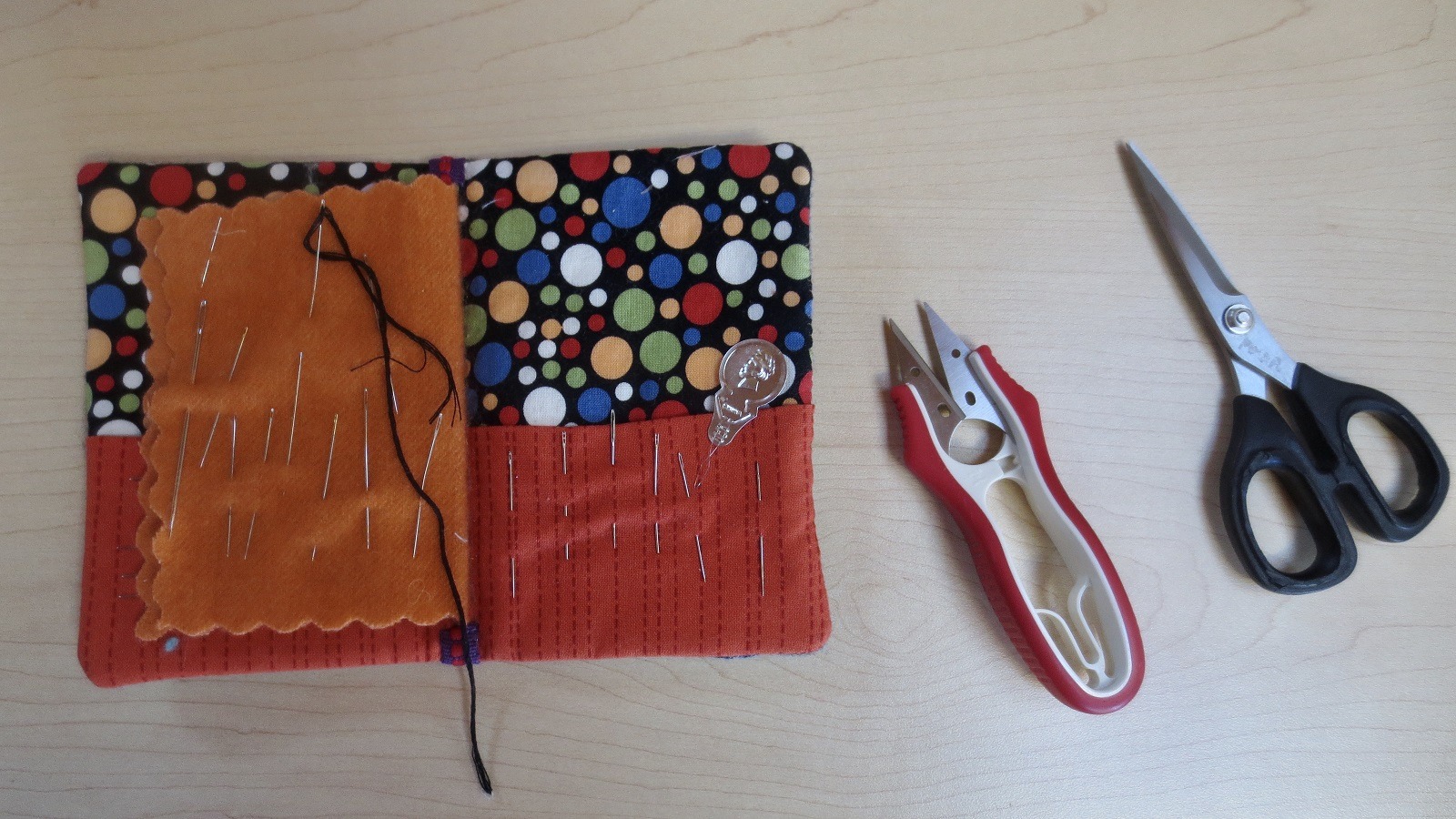
What equipment did you use in the creation of the piece and how was it used?
Working on Journeys into Unknown Territory did not call for any special equipment, just needles with variously-sized eyes and a pair of small scissors or snippers. And, of course, I used a variety of materials to stitch with.
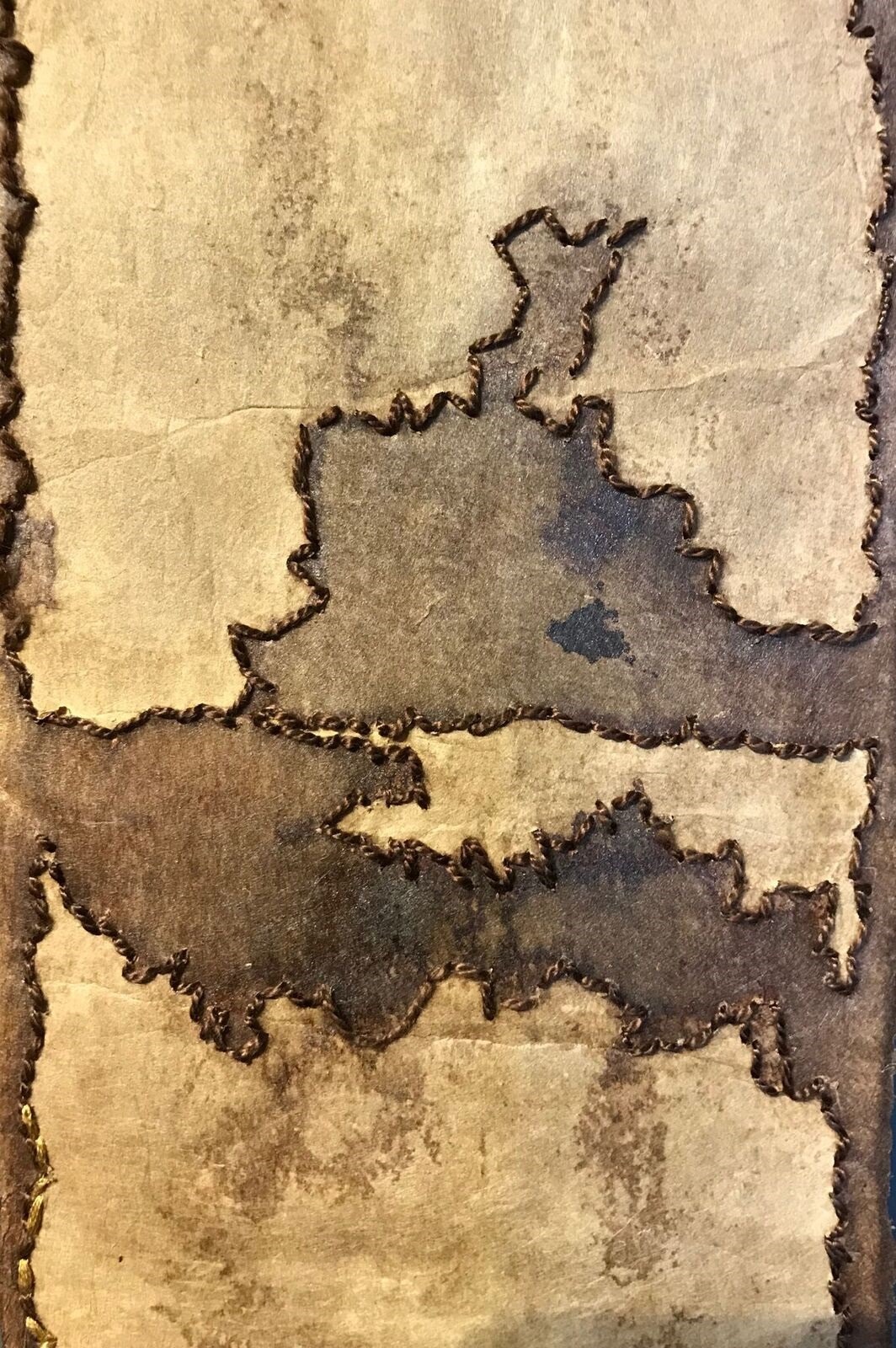
Simply making marks
Take us through the creation of the piece stage by stage
After I returned to California, I don’t recall how many months elapsed before, one day, I picked up a piece from my little pile, sat down, and started stitching with embroidery floss. I would set it down, come back to it later, the next day, or several days afterwards, and carefully add more marks to the paper. I was concerned about making holes, even with the thinnest needle, but that was unavoidable. With fabric, needle holes can be closed up with moisture and an iron or a tumble in the dryer, but not so with paper. Also, though hanji is highly durable (in a museum, I saw an example that was 1,000 years old), it was far too risky to place it in a hoop, so I held it gingerly to avoid causing tears, cracks, or broken-off bits.
As I stitched, I didn’t know where I was headed nor how I would get there. Still, I just kept going. After I finished my first strip, I realized that the naturally occurring contours of colour in the handmade paper reminded me of shapes in landscapes. I didn’t have to dye or paint the paper; it was perfect just as it was.
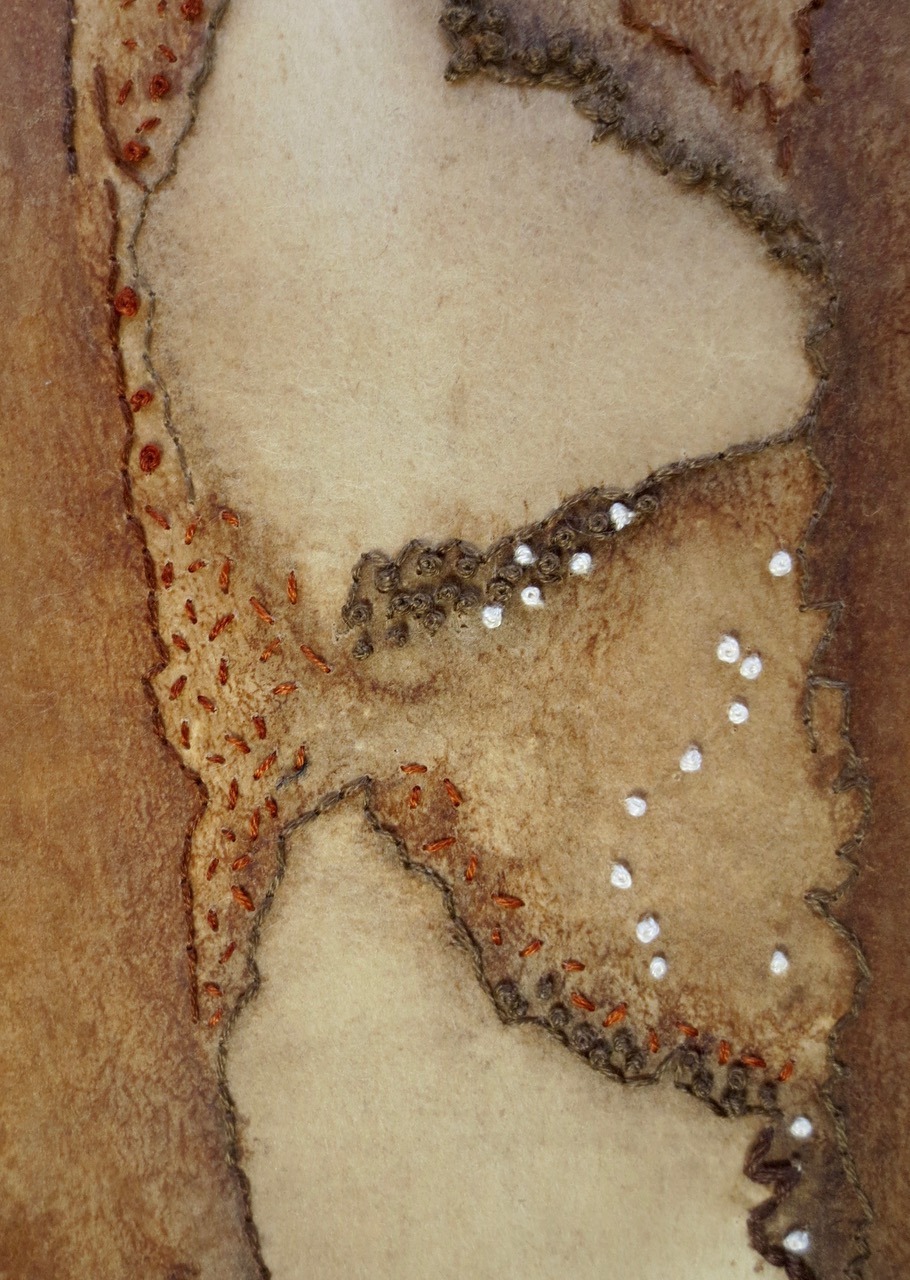
As time permitted, I began to concentrate on another strip. And so on, each one emerging entirely sui generis, with seed stitches, French knots, backstitching, couching, cross stitching, satin stitch, etc. Along with floss, I incorporated perle cotton, yarn, and raffia, all in natural colours compatible with the organic hanji. I wasn’t specifically embroidering, simply making marks intuitively.
By the time I completed all the pieces I’d brought home, I was totally smitten with Master Jang’s hanji and couldn’t wait to return to the shop in Seoul. Working quietly alone, I very much appreciated and enjoyed the meditative nature of the process. Instead of pushing fabric through a sewing machine, I felt a pleasant congruence between hand stitching and handmade paper. I wanted more!
During the next trip to Korea, I selected additional strips and, once I was in my California studio again, I continued making marks. I became aware that each stitched “page” was akin to an internal passage in an imagined rather than a real landscape. It was like creating a loosely leafed travel diary, without watercolours, pencils, or binding.
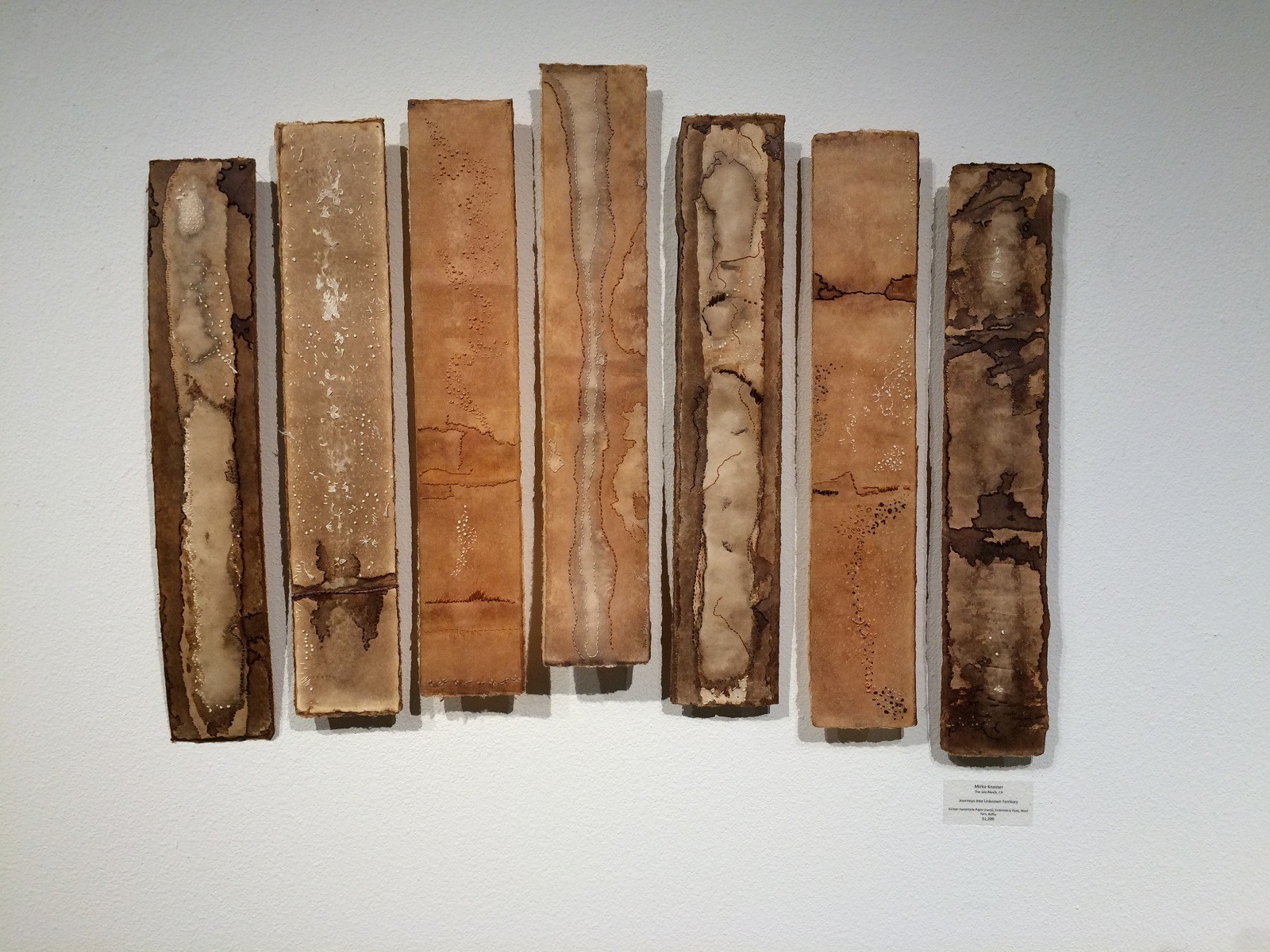
What journey has the piece been on since its creation?
I have hung the stitched “pages” in groups of seven or thirteen in galleries and art centers in Reno, Nevada, and northern California. I use insect pins to make a tiny hole in each upper corner and lightly tap them into the wall with a lightweight ball peen hammer. Whenever possible, I move the strips slightly forward on the pins for a shadow effect and for the lightest movement as air circulates in the area. The details on each strip beckon viewers to come closer and see the many variations of each journey. They have an opportunity to picture where it might be and perhaps relate aspects of it to their own unique passages.
For me, Journeys into Unknown Territory is representative of life itself, for, who among us ever truly knows what or where is next? Certainly, the COVID-19 pandemic has made us all keenly aware that uncertainty undergirds both our daily existence and plans for the future. Similarly, Journeys reflects the creative process that I described. It is also a trope for the experience of emigration/immigration. Having emigrated from Italy to the United States as a young child, I understand how challenging such a journey is, and I empathize with and try to support others who undergo it.
Like immigrants everywhere throughout history, my refugee parents and I left Europe and ventured on a voyage toward a land that was a mystery to us—geographically, culturally, and linguistically. I was far too young to wonder where we were going and what kind of life we would find there. Thus, these stitched “pages” do not depict any particular known landscapes, yet they are reminiscent and evocative of places immigrants travel internally and externally in order to reach safety. Immigrants travel up and down rivers, across mountains and oceans, through canyons, swamps, deserts, and forests. Sometimes they sleep under starry skies; at other times, they are tossed about in the midst of storms. When we stop to consider the background of any family, we are all immigrants. It’s only a question of when.

For more information visit //mirkaart.com/
Has Mirka’s work ‘Journeys into the Unknown’ prompted you to try something new? Let us know in the comments below.
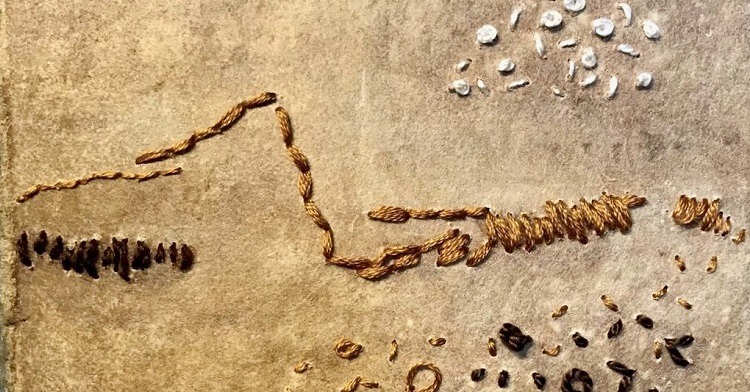

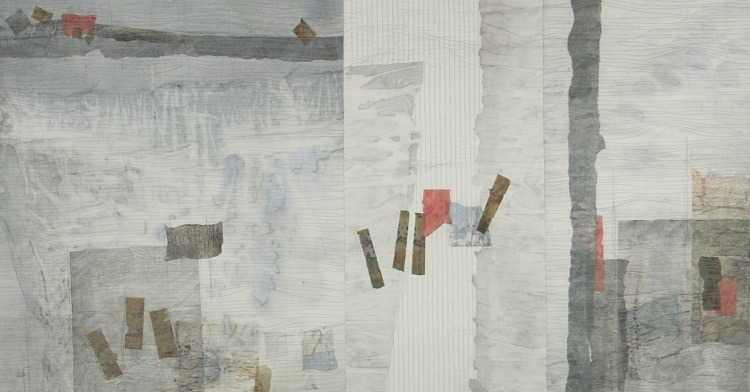
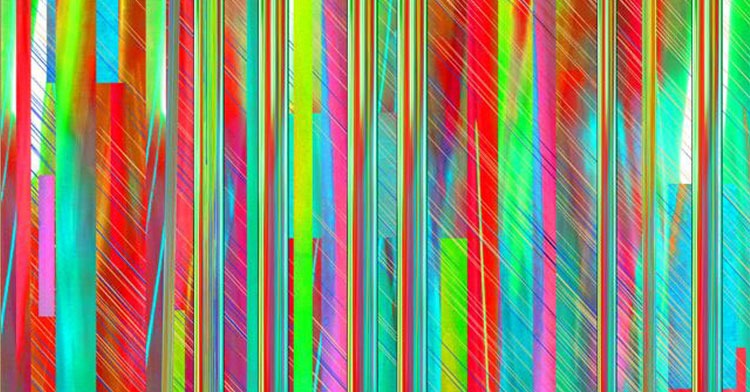
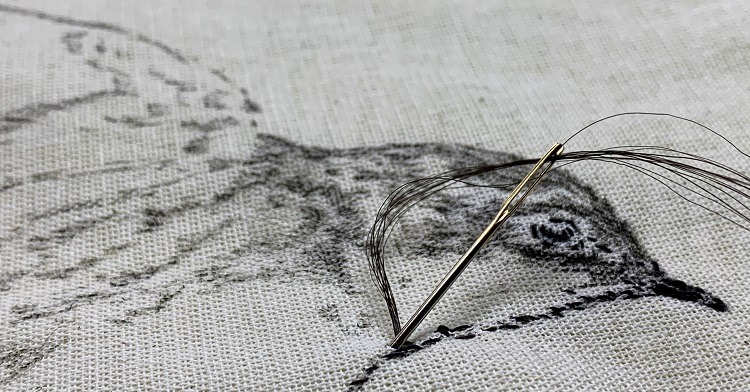
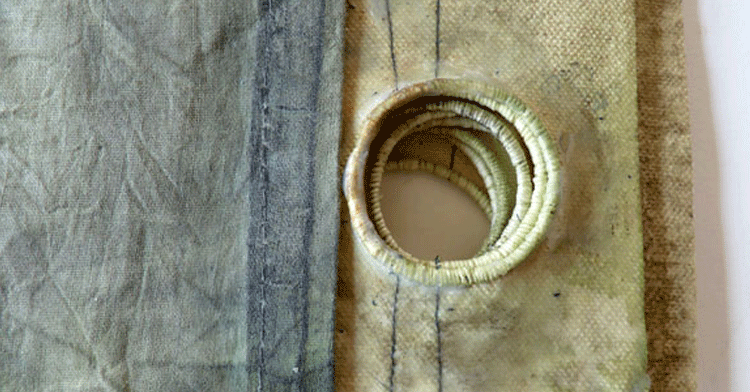
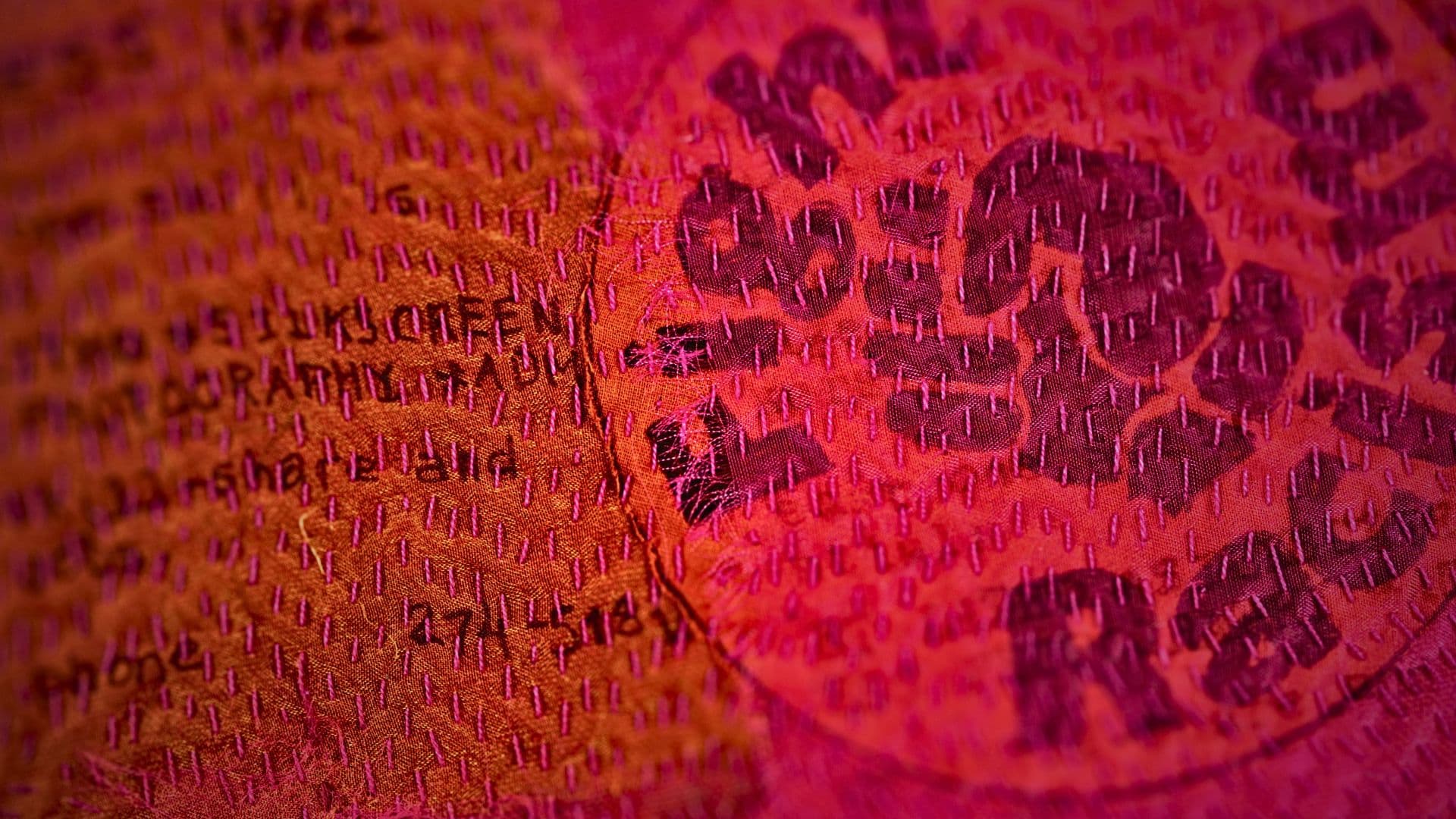
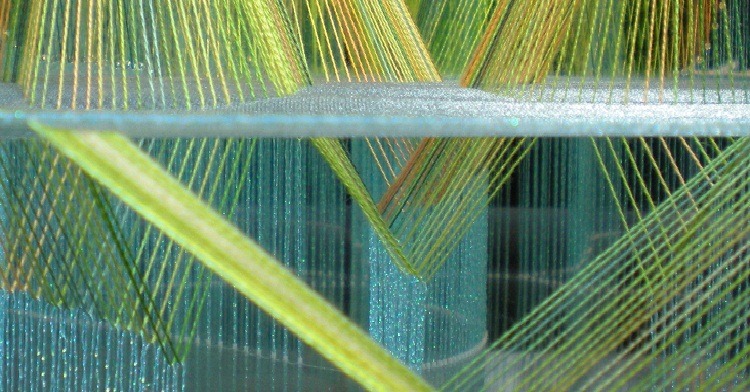
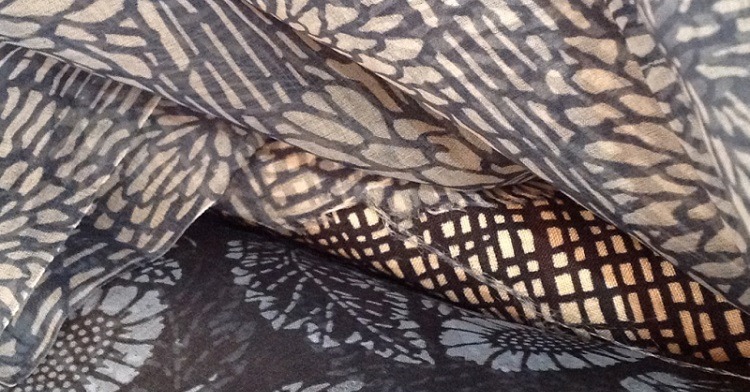
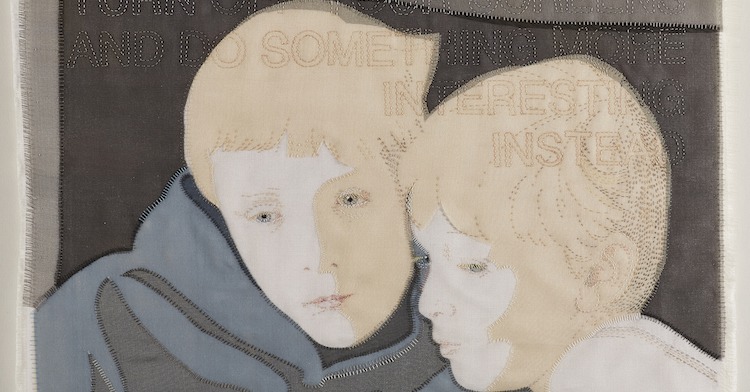
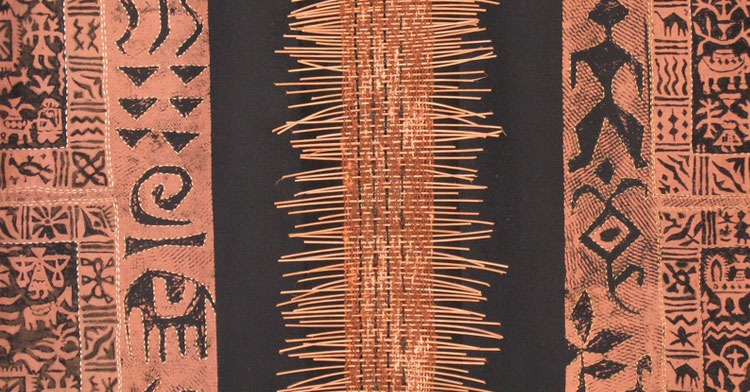
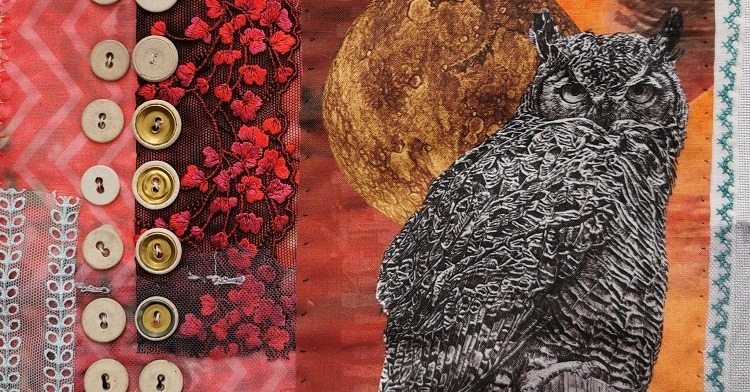
18 comments
Barbara Cordio
I am an Art Quilter and has admired yours and others work. I would like to receive your newsletter.
Thank you for sharing.
amberley
Hello Barbara, thank you so much. You can sign up to our newsletter here https://training.textileartist.org/newsletter-sign-up/ All the best, Amberley from TextileArtist.org
Donna Sandberg
Thank you for your inspiring work! I enjoy working intuitively and the (slow) process of letting my work grow. Living on a farm, surrounded by beautiful images & sounds, it’s always thought-provoking. Your work will stay in my heart and mind for future reference.
Ann
Mind opening as well as mind blowing. Can’t wait to give this a go on some ‘chunky’ hand made paper I’ve got in my stash. I’ve machinr stitched delicately into collaged tissue but love the robust, organic look of these pieces. And there’s a bonus of them bringing back happy memories of a solo road trip around parts of California that included Pt Reyes. In September the hills were covered in dry grass, there were elk grazing, and there was the coastline down below the road – and these pieces made all these images surge back into my mind’s eye. Thank you.
Helen Homer
Are your works for sale. I’m interested in the first image- a landscape?
Thank you.
Helen Homer
Charlotte Tefft
Mirka,
Serendipity is the word of today. I look forward to your words of perspective of the arts each month. They always open my mind to creative thinking. Covid isolation has been difficult yet it has opened many creative windows. Today is the first day of having electricity after a horrendous storm nine days ago. Stitching has kept my life alive, fed by artistic freedom. To turn on the computer, see what Textileartist.org of London had posted, joy to see your name!!. Wonderful to read this interview. Thank you for sharing your glow in life.
Mirka Knaster
Thank you, Charlotte. I’m happy to know my blog posts are something you look forward to. How wonderful that stitching is such a lifeline for you and so many others.
Heather Dubreuil
Mirka, I have subscribed to your newsletter for many years. I often share the link with others because I know they will also find inspiration in your observations. The description of your process in this profile is very evocative. I came away with the sense that you were truly carried away by your muse while responding to the beauty of the materials. Rather than imposing your will on the papers, you let them speak to you, and responded to them with needle and thread.
Mirka Knaster
Thank you, Heather. It’s been a delight to have you along for my exploration of the arts and also to witness the evolution of your artwork.
Donna
Mirka this is so timely for me. Just yesterday I dyed some papers with flowers from my garden and rust. They turned out so beautiful and I was wondering if I might add stitches. I usually do fabric art pieces .Since following this group I have really stepped out of my comfort zone and have added a lot of hand stitching to my pieces. Thank you for this wonderful article .
Dorothy Yuki
Hi Mirka,
Love your paper stitch art. I live in San Francisco and would love to meet you someday. I am also a lover of paper and stitching. Love to know if you are exhibiting now and where.
Mirka Knaster
Dear Dorothy,
Thank you for your interest. Post-Covid, I would be delighted to meet you in SF, as I’m usually down in the Bay Area once a month. My work was exhibited last year in Pt. Reyes and Sebastopol and some online venues. Just check the list on my website. In July, I will be part of a 3-artists exhibit at the Gualala Arts Center. Please feel free to contact me through my website.
all good wishes,
Mirka
Harmony
Mirka has a way of weaving a universal story into her deeply personal work. Love it!
Patricia V Merrell
absolutely fascinating – thank you so much Textile Arts for giving us her story as well as this particular piece – very inspiring and fits right in with some paper and hand stitch I have been “sitting on” – well get down to it!
Celia
I love Mirka’s intuitive, unstructured and down to earth approach to her creative practice.
Eva
This gives me plenty of inspiration! I work on different fibers and have discovered that I also can work with stitch on papers so to read this was very interesting. I live in Sweden, so if it were not for the language I would have written more. Thank you for the newsletter!
Mirka Breen
Evocative work from a deep thinker who chose to express her ideas in texture and lines. Thank you for an illuminating interview.
Anna Marion Wildey
Absolutely awesome on every level. Thank you Anna